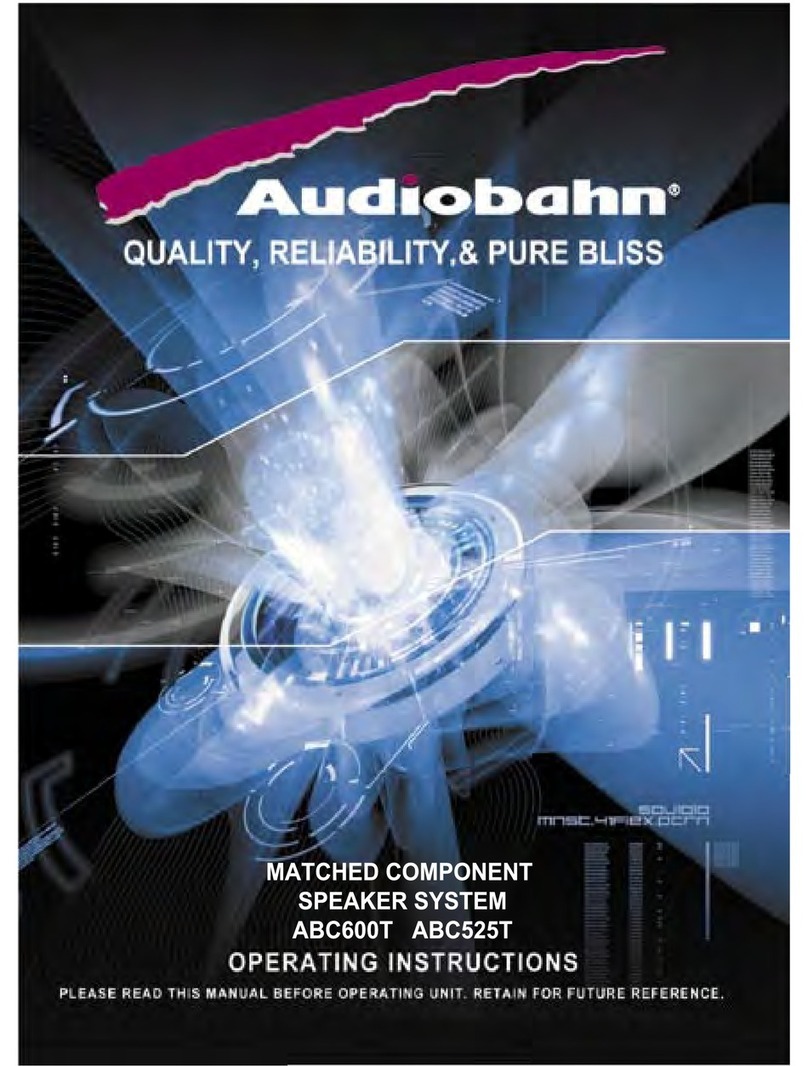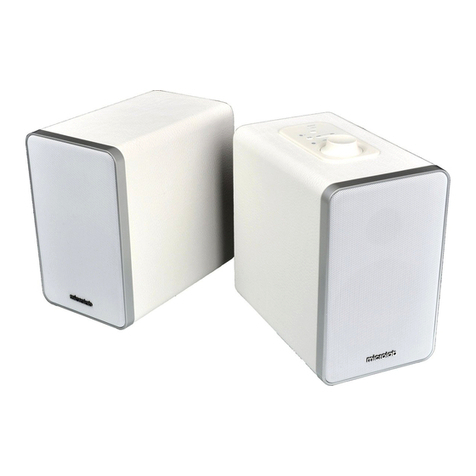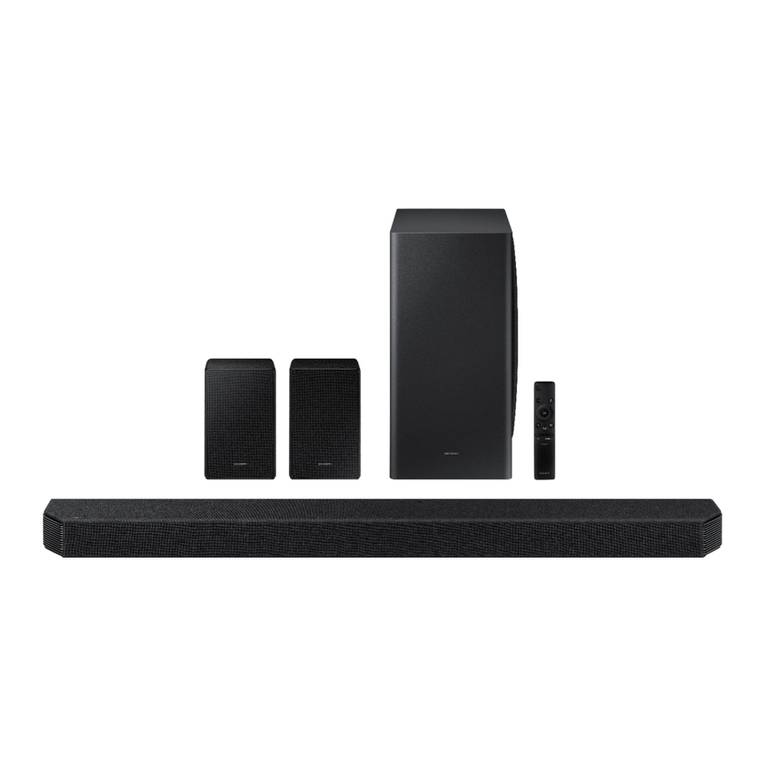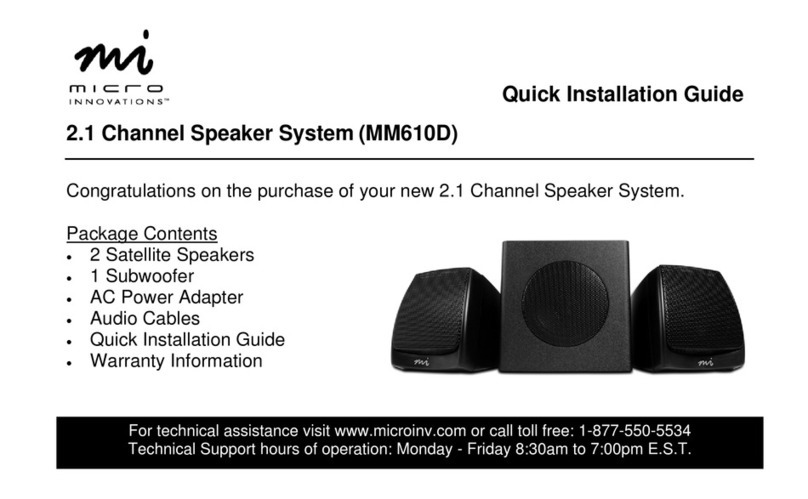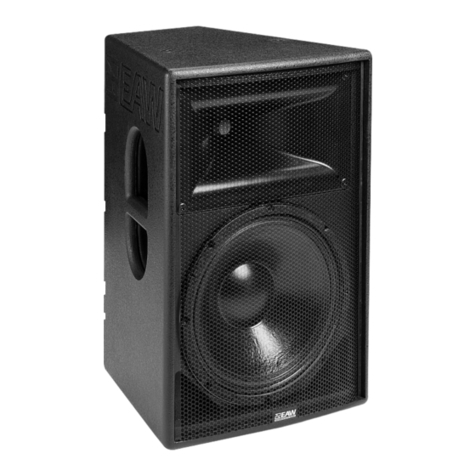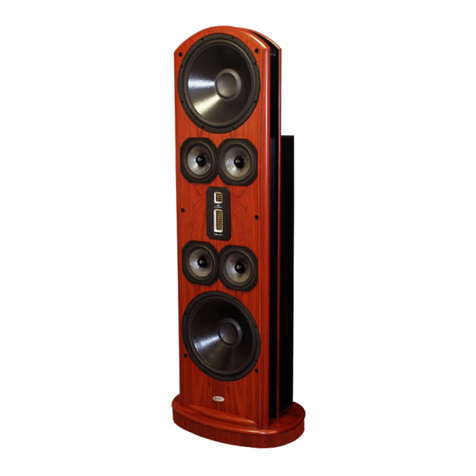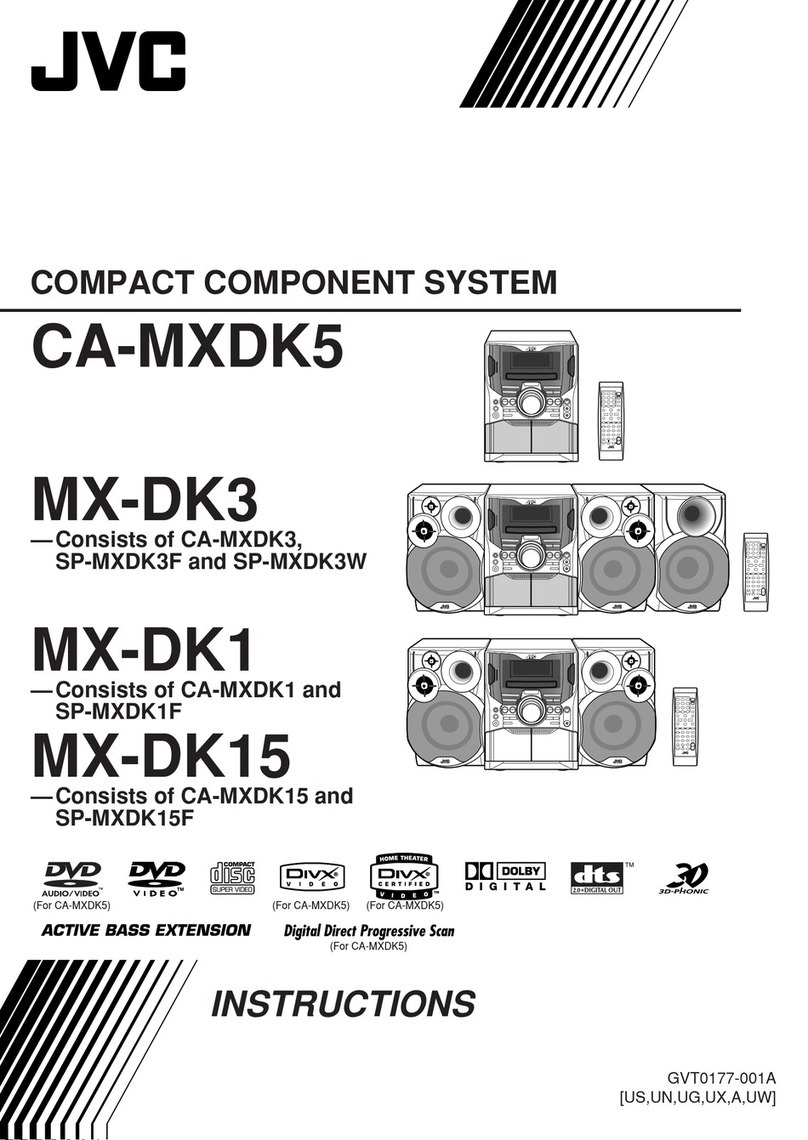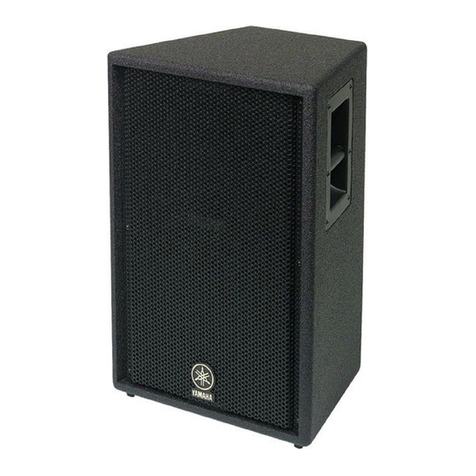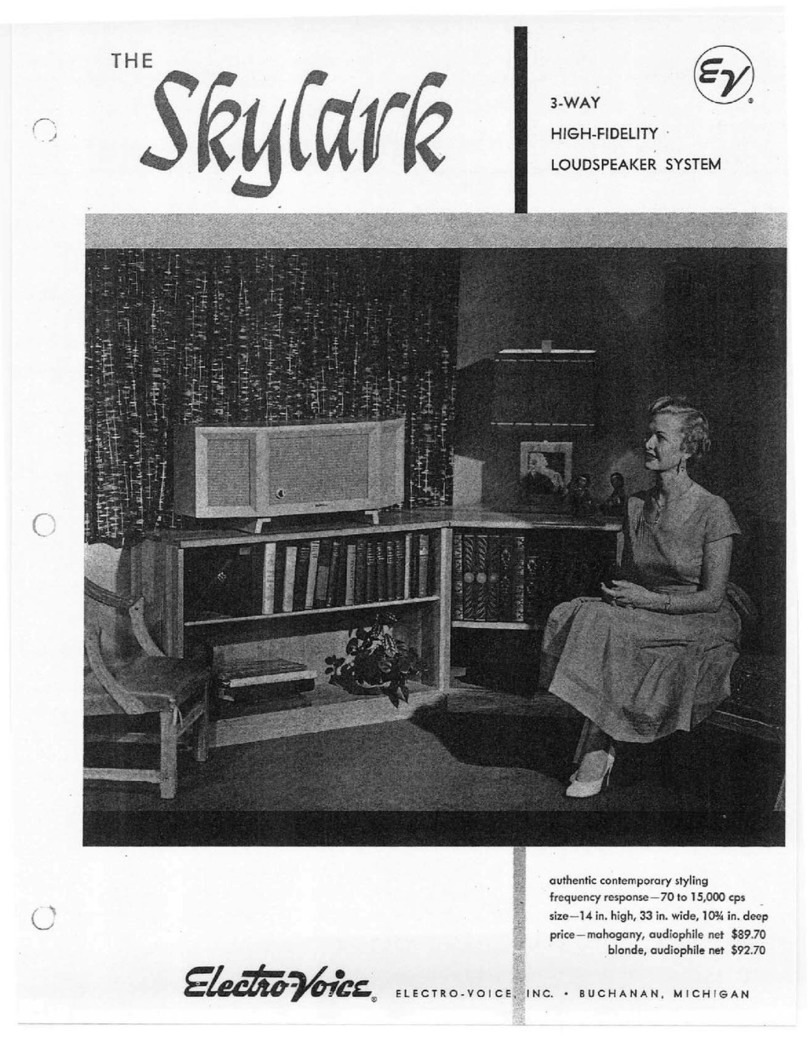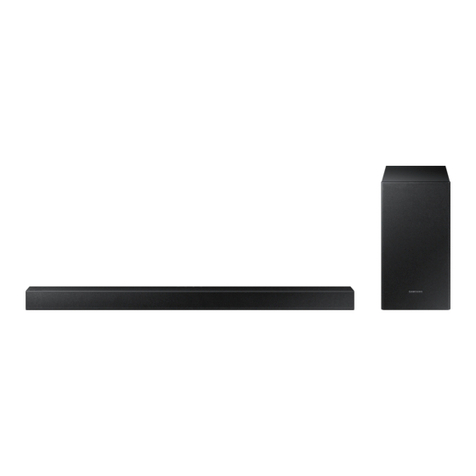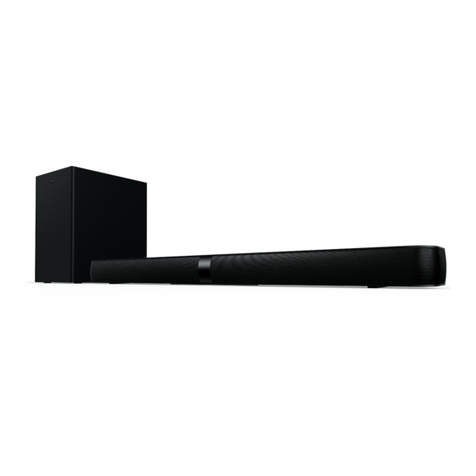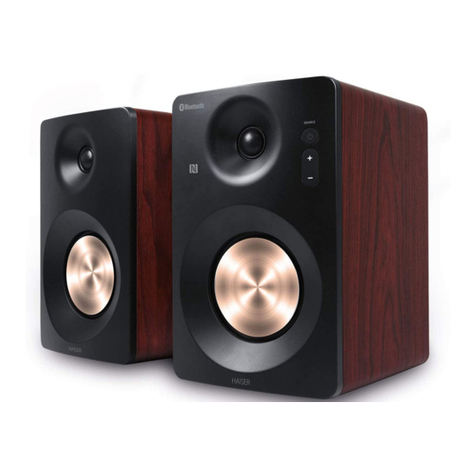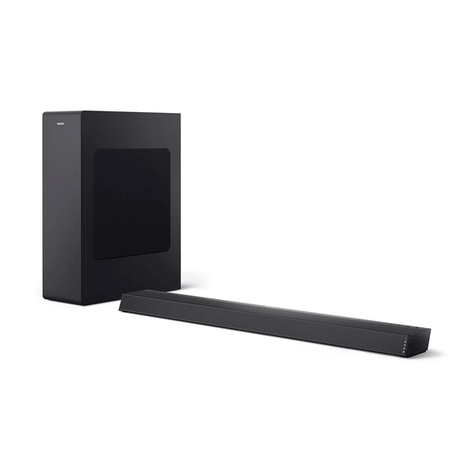IMG Stage Series User manual

BEDIENUNGSANLEITUNG • INSTRUCTION MANUAL
MODE D’EMPLOI • ISTRUZIONI PER L’USO • MANUAL DE INSTRUCCIONES
INSTRUKCJA OBSŁUGI • VEILIGHEIDSVOORSCHRIFTEN
SIKKERHEDSOPLYSNINGER • SÄKERHETSFÖRESKRIFTER • TURVALLISUUDESTA
AKTIV-LAUTSPRECHERBOX
ACTIVE SPEAKER SYSTEM
ENCEINTE ACTIVE
CASSA ACUSTICA ATTIVA
PAK-210 MK2 Bestellnummer 25.3890
PAK-212 MK2 Bestellnummer 25.3900
PAK-215 MK2 Bestellnummer 25.3910

2
Bevor Sie einschalten …
Wir wünschen Ihnen viel Spaß mit Ihrem neuen
Gerät von „img Stage Line“. Bitte lesen Sie diese
Bedienungsanleitung vor dem Betrieb gründlich
durch. Nur so lernen Sie alle Funktionsmöglich-
keiten kennen, vermeiden Fehlbedienungen und
schützen sich und Ihr Gerät vor eventuellen Schä-
den durch unsachgemäßen Gebrauch. Heben
Sie die Anleitung für ein späteres Nachlesen auf.
Der deutsche Text beginnt auf der Seite 4.
Before switching on …
We wish you much pleasure with your new “img
Stage Line” unit. Please read these operating
instructions carefully prior to operating the unit.
Thus, you will get to know all functions of the unit,
operating errors will be prevented, and yourself
and the unit will be protected against any damage
caused by improper use. Please keep the oper-
ating instructions for later use.
The English text starts on page 7.
Avant toute installation …
Nous vous souhaitons beaucoup de plaisir à uti-
liser cet appareil “img Stage Line”. Lisez ce mode
dʼemploi entièrement avant toute utilisation. Uni-
quement ainsi, vous pourrez apprendre lʼensem-
ble des possibilités de fonctionnement de lʼappa-
reil, éviter toute manipulation erronée et vous
protéger, ainsi que lʼappareil, de dommages
éventuels engendrés par une utilisation inadap-
tée. Conservez la notice pour pouvoir vous y
reporter ultérieurement.
La version française se trouve page 10.
Prima di accendere …
Vi auguriamo buon divertimento con il vostro
nuovo apparecchio di “img Stage Line”. Leggete
attentamente le istruzioni prima di mettere in fun-
zione lʼapparecchio. Solo così potete conoscere
tutte le funzionalità, evitare comandi sbagliati e
proteggere voi stessi e lʼapparecchio da even-
tuali danni in seguito ad un uso improprio. Con-
servate le istruzioni per poterle consultare anche
in futuro.
Il testo italiano inizia a pagina 13.
D
A
CH
GB
Innan du slår på enheten …
Vi önskar dig mycket glädje med din nya “img
Stage Line” produkt. Läs igenom säkerhetsföre-
skrifterna innan enheten tas i bruk för att undvika
skador till följd av felaktig hantering. Behåll
instruktionerna för framtida bruk.
Säkerhetsföreskrifterna återfinns på sidan 23.
F
B
CH
I
SFIN
Antes de la utilización …
Le deseamos una buena utilización para su nue-
vo aparato “img Stage Line”. Por favor, lea estas
instrucciones de uso atentamente antes de hacer
funcionar el aparato. De esta manera conocerá
todas las funciones de la unidad, se prevendrán
errores de operación, usted y el aparato estarán
protegidos en contra de todo daño causado por
un uso inadecuado. Por favor, guarde las instruc-
ciones para una futura utilización.
El texto en español empieza en la página 16.
Voor u inschakelt …
Wij wensen u veel plezier met uw nieuwe appa-
raat van “img Stage Line”. Lees de veiligheids-
voorschriften grondig door, alvorens het apparaat
in gebruik te nemen. Zo behoedt u zichzelf en het
apparaat voor eventuele schade door ondeskun-
dig gebruik. Bewaar de handleiding voor latere
raadpleging.
De veiligheidsvoorschriften vindt u op pagina 22.
Przed uruchomieniem …
Zyczymy zadowolenia z nowego produktu “img
Stage Line”. Dzięki tej instrukcji obsługi będą
państwo w stanie poznać wszystkie funkcje tego
urządzenia. Stosując się do instrukcji unikną
państwo błędów i ewentualnego uszkodzenia
urządzenia na skutek nieprawidłowego użytko-
wania. Prosimy zachować instrukcję.
Tekst polski zaczyna się na stronie19.
Før du tænder …
Tillykke med dit nye “img Stage Line” produkt.
Læs sikkerhedsanvisningerne nøje før ibrugtag-
ning, for at beskytte Dem og enheden mod ska-
der, der skyldes forkert brug. Gem manualen til
senere brug.
Sikkerhedsanvisningerne findes på side 22.
E PL
DK
NL
B
wwwwww..iimmggssttaaggeelliinnee..ccoomm
Ennen kytkemistä …
Toivomme Sinulle paljon miellyttäviä hetkiä uuden
“img Stage Line” laitteen kanssa. Ennen laitteen
käyttöä pyydämme Sinua huolellisesti tutustu-
maan turvallisuusohjeisiin. Näin vältyt vahingoilta,
joita virheellinen laitteen käyttö saattaa aiheuttaa.
Ole hyvä ja säilytä käyttöohjeet myöhempää tar-
vetta varten.
Turvallisuusohjeet löytyvät sivulta 23.

3

D
A
CH
Auf der ausklappbaren Seite 3 finden Sie alle be-
schriebenen Bedienelemente und Anschlüsse.
1 Übersicht der Bedienelemente
und Anschlüsse
1Eingang INPUT als XLR-Buchse zum An-
schluss einer Signalquelle mit Line-Pegel (z. B.
Mischpult)
2Ausgang PAR. OUTPUT als XLR-Buchse zum
Weiterleiten des Eingangssignals z. B. zu einer
weiteren Aktiv-Lautsprecherbox
3Schalter FILTER MODE für das Hochpassfilter:
„HP 100 Hz“: Tieftonabschwächung
„FULL RANGE“: Filter aus
4Lautstärkeregler GAIN
5LED LIMITER; leuchtet, wenn die Pegelbegren-
zung aktiv ist
6LED SIGNAL; zeigt Signalspitzen an
7Betriebsanzeige POWER
8Kühlrippen
9Netzschalter POWER
10 Halterung für die Netzsicherung
Eine durchgebrannte Sicherung nur durch eine
gleichen Typs ersetzen.
11 Netzbuchse zum Anschluss an eine Steckdose
(230 V~/50 Hz) über das beiliegende Netzkabel
2 Hinweise
für den sicheren Gebrauch
Das Gerät entspricht allen relevanten Richtlinien
der EU und ist deshalb mit gekennzeichnet.
Beachten Sie auch unbedingt die folgenden
Punkte:
GVerwenden Sie das Gerät nur im Innenbereich
und schützen Sie es vor Tropf- und Spritzwasser,
hoher Luftfeuchtigkeit und Hitze (zulässiger Ein-
satztemperaturbereich 0 – 40 °C).
GStellen Sie keine mit Flüssigkeit gefüllten Ge-
fäße, z. B. Trinkgläser, auf das Gerät.
GDie in der Lautsprecherbox entstehende Wärme
wird durch die Kühlrippen (8) abgegeben.
Decken Sie diese deshalb nicht ab. Stellen Sie
die Box nie direkt an eine Wand; halten Sie einen
entsprechenden Abstand ein.
GNehmen Sie das Gerät nicht in Betrieb oder zie-
hen Sie sofort den Netzstecker aus der Steck-
dose,
1. wenn sichtbare Schäden am Gerät oder am
Netzkabel vorhanden sind,
2. wenn nach einem Sturz oder Ähnlichem der
Verdacht auf einen Defekt besteht,
3. wenn Funktionsstörungen auftreten.
Geben Sie das Gerät in jedem Fall zur Reparatur
in eine Fachwerkstatt.
GZiehen Sie den Netzstecker nie am Kabel aus
der Steckdose, fassen Sie immer am Stecker an.
GVerwenden Sie für die Reinigung nur ein trocke-
nes, weiches Tuch, niemals Wasser oder Chemi-
kalien.
GWird das Gerät zweckentfremdet, nicht richtig
installiert, falsch bedient oder nicht fachgerecht
repariert, kann keine Haftung für daraus resultie-
rende Sach- oder Personenschäden und keine
Garantie für das Gerät übernommen werden.
3 Einsatzmöglichkeiten
Die PAK-210MK2, PAK-212MK2 und PAK-215MK2
sind leistungsfähige Aktiv-Lautsprecherboxen in
robusten Holzgehäusen. Sie sind vielseitig einsetz-
bar, z. B. für Tanzveranstaltungen, zur Ausstattung
kleinerer Bühnen oder als Monitorlautsprecher in
einer Band. Die Lautsprecher sind als 2-Wege-
Systeme ausgeführt mit jeweils einem eigenen Ver-
stärker für den Hochton- und Tieftonbereich.
Alle Lautsprecherboxen verfügen über einen
regelbaren, symmetrischen Signaleingang. Ein
zusätzlicher Signalausgang ermöglicht z. B. den
Anschluss einer weiteren Aktiv-Lautsprecherbox.
Mithilfe eines schaltbaren Filters können tieffre-
quente Signalanteile abgeschwächt werden (z. B.
beim Betrieb der Lautsprecherbox zusammen mit
einem Subwoofer).
Die Verstärker sind gegen Überlastung mit
einem Limiter und mit Schutzschaltungen gegen
Überhitzung ausgestattet.
Soll das Gerät endgültig aus dem Betrieb
genommen werden, übergeben Sie es zur
umweltgerechten Entsorgung einem örtli-
chen Recyclingbetrieb.
WARNUNG Das Gerät wird mit lebensgefährlich
hoher Netzspannung versorgt. Neh-
men Sie deshalb niemals selbst Ein-
griffe am Gerät vor. Es besteht die
Gefahr eines elektrischen Schlages.
4

D
A
CH
5
4 Aufstellen und Anschließen
Die Lautsprecherbox auf einen festen Untergrund
z. B. auf die Bühne oder einen Tisch stellen und auf
die Zuhörer ausrichten. Die Hochtöner sollten sich
möglichst auf Ohrhöhe befinden. Mit ihrer abge-
schrägten Gehäuseform und den zusätzlichen
Gummifüßen an der Seite kann die Box auch als
schräg nach oben abstrahlender Bühnenmonitor
eingesetzt werden.
Alternativ kann die Lautsprecherbox über die
Stativhülse in der Unterseite auf ein Standard-Laut-
sprecherstativ mit 35 mm Rohrdurchmesser ge-
stellt werden (z. B. aus der PAST-Serie von „img
Stage Line“).
Für zusätzliche Montagemöglichkeiten, z. B.
Aufhängung, sind M8-Gewindebuchsen in das
Gehäuse eingelassen. Um diese zu nutzen, die
betreffenden Abdeckschrauben (Inbus) entfernen.
Bei der Positionierung der Lautsprecherbox
immer darauf achten, dass Luft ungehindert durch
die Kühlrippen (8) an der Rückseite strömen kann,
damit eine ausreichende Kühlung gewährleistet ist.
Vor dem Anschluss bzw. vor dem Ändern beste-
hender Anschlüsse die Lautsprecherbox und die
anzuschließenden Geräte ausschalten.
4.1 Signalquelle anschließen
Eine Signalquelle mit Line-Pegel (z. B. Mischpult-
ausgang) an die XLR-Buchse INPUT (1) anschlie-
ßen. Die Buchse ist für den Anschluss von symme-
trischen Signalen vorgesehen [Belegung der
Kontakte Kapitel 6]. Sollen Signalquellen mit
asymmetrischen Ausgängen angeschlossen wer-
den, einen Adapter verwenden, bei dem die XLR-
Kontakte 1 und 3 gebrückt sind.
4.2 Durchschleifausgang
Die XLR-Buchse PAR. OUTPUT (2) ist der Buchse
INPUT parallel geschaltet. Hier kann z. B. eine wei-
tere Aktiv-Lautsprecherbox angeschlossen wer-
den, die dasselbe Eingangssignal bekommen soll.
4.3 Stromversorgung
Das beiliegende Netzkabel an die Netzbuchse (11)
anschließen und den Stecker in eine Steckdose
(230 V~/50 Hz) stecken.
5 Bedienung
Hinweis: Um Schaltgeräusche zu vermeiden, die
Aktiv-Lautsprecherbox immer nach der
angeschlossenen Signalquelle einschal-
ten und nach dem Gebrauch als erstes
Gerät ausschalten.
1) Den Regler GAIN (4) zunächst auf Minimum
(Linksanschlag) stellen und den Verstärker mit
dem Schalter POWER (9) einschalten. Die LED
POWER (7) leuchtet.
2) Bei Bedarf das Hochpassfilter einschalten, z. B.
wenn die Box zusammen mit einem Subwoofer
betrieben wird, um diesem die Tieftonwieder-
gabe zu überlassen oder zum Unterdrücken tief-
frequenter Störgeräusche (Trittschall).
„HP 100 Hz“: Tieftonabschwächung
„FULL RANGE“: Filter aus
3) Mit dem Regler GAIN die gewünschte Laut-
stärke einstellen. Den Regler nur so weit aufdre-
hen, dass der Ton nicht verzerrt wiedergegeben
wird. Die LED LIMITER (5) leuchtet, wenn der
Signalpegel so hoch ist, dass die Pegelbegren-
zung einsetzt. Leuchtet diese LED häufig, den
Regler GAIN entsprechend zurückdrehen.
4) Nach dem Gebrauch die Lautsprecherbox mit
dem Schalter POWER wieder ausschalten.
VORSICHT Stellen Sie die Lautstärke nie sehr
hoch ein. Hohe Lautstärken können
auf Dauer das Gehör schädigen! Das
Ohr gewöhnt sich an sie und empfin-
det sie nach einiger Zeit als nicht
mehr so hoch. Darum eine hohe
Lautstärke nach der Gewöhnung
nicht weiter erhöhen.

6
D
A
CH
Diese Bedienungsanleitung ist urheberrechtlich für MONACOR
®
INTERNATIONAL GmbH & Co. KG
geschützt. Eine Reproduktion für eigene kommerzielle Zwecke – auch auszugsweise – ist untersagt.
6 Technische Daten
Kontaktbelegung der Anschlüsse:
Änderungen vorbehalten.
1 = Masse
2 = Signal +
3 = Signal
-
Modell PAK-210MK2 PAK-212MK2 PAK-215MK2
Verstärkerleistung
Sinusleistung (Hochton + Tiefton)
Spitzenleistung (gesamt)
50 W + 200 W
400 W
80 W + 220 W
500 W
100 W + 300 W
600 W
Frequenzbereich 65 – 20 000 Hz 50 – 20 000 Hz 45 – 20 000 Hz
Max. Nennschalldruck 120 dB 123 dB 125 dB
Basslautsprecher ∅25 cm (10″) ∅30 cm (12″) ∅38 cm (15″)
Hochtonlautsprecher
Schwingspule
dynamischer Hornhochtöner, ∅2,54 cm (1″)
∅34 mm ∅44 mm
Eingangsempfindlichkeit
Max. Eingangsspannung
Eingangsimpedanz
1V
7V
11 kΩ
Hochpassfilter (schaltbar) 100 Hz mit 6 dB/Oktave
Einsatztemperatur 0 – 40 °C
Stromversorgung
max. Leistungsaufnahme
230 V~/50 Hz
460 VA
230 V~/50 Hz
625 VA
230 V~/50 Hz
625 VA
Abmessungen (B × H × T)
Gewicht
340 × 565 × 330 mm
19,5 kg
400 × 635 × 345 mm
25,2 kg
470 × 775 × 440 mm
32,5 kg

All operating elements and connections de-
scribed can be found on the fold-out page 3.
1 Operating Elements
and Connections
1XLR jack INPUT for connection of a signal
source with line level (e. g. mixer)
2XLR jack PAR. OUTPUT for routing the input
signal, e. g. to another active speaker system
3Switch FILTER MODE for the high pass filter:
“HP 100 Hz”: bass attenuation
“FULL RANGE”: filter off
4Volume control GAIN
5LED LIMITER; lights up when the level limitation
is active
6LED SIGNAL; shows signal peaks
7POWER LED
8Cooling fins
9POWER switch
10 Support for the mains fuse
Only replace a blown fuse by one of the same
type.
11 Mains jack for connection to a mains socket
(230 V~/50 Hz) via the supplied mains cable
2 Safety Notes
The unit corresponds to all relevant directives of
the EU and is therefore marked with .
It is essential to observe the following items:
GThe unit is suitable for indoor use only. Protect it
against dripping water and splash water, high air
humidity, and heat (admissible ambient tempera-
ture range 0 – 40 °C).
GDo not place any vessels filled with liquid, e. g.
drinking glasses, on the unit.
GThe heat generated inside the speaker system
must be dissipated by the cooling fins (8). There-
fore, they must not be covered. Never place the
speaker system directly on a wall; keep a corre-
sponding distance.
GDo not set the unit into operation, or immediately
disconnect the mains plug from the mains socket if
1. there is visible damage to the unit or to the
mains cable,
2. a defect might have occurred after a drop or
similar accident,
3. malfunctions occur.
The unit must in any case be repaired by skilled
personnel.
GNever pull the mains cable to disconnect the
mains plug from the mains socket, always seize
the plug.
GFor cleaning only use a dry, soft cloth, never use
chemicals or water.
GNo guarantee claims for the unit and no liability
for any resulting personal damage or material
damage will be accepted if the unit is used for
other purposes than originally intended, if it is not
correctly mounted or operated, or not repaired in
an expert way.
GImportant for U. K. Customers!
The wires in this mains lead are coloured in
accordance with the following code:
green/yellow = earth
blue = neutral
brown = live
As the colours of the wires in the mains lead of
this appliance may not correspond with the
coloured markings identifying the terminals in
your plug, proceed as follows:
1. The wire which is coloured green and yellow
must be connected to the terminal in the plug
which is marked with the letter E or by the earth
symbol , or coloured green or green and yel-
low.
2. The wire which is coloured blue must be con-
nected to the terminal which is marked with the
letter N or coloured black.
3. The wire which is coloured brown must be con-
nected to the terminal which is marked with the
letter L or coloured red.
Warning – This appliance must be earthed.
3 Applications
The PAK-210MK2, PAK-212MK2 and PAK-215MK2
are powerful active speaker systems in robust
wooden cabinets. They are suited for versatile
applications, e. g. for dances, for small stages or as
monitor speakers in a band. The two-way speaker
systems are each equipped with an individual
amplifier for the high range and the bass range.
All speaker systems have an adjustable, bal-
anced signal input. An additional signal output
If the unit is to be put out of operation
definitively, take it to a local recycling plant
for a disposal which is not harmful to the
environment.
WARNING The unit is supplied with hazardous
mains voltage. Leave servicing to
skilled personnel only. Inexpert hand-
ling or modification of the unit may
cause an electric shock hazard.
7
GB

allows e. g. connection of another active speaker
system. By means of a switchable filter, low-fre-
quent signal parts can be attenuated (e. g. when
operating the speaker system together with a sub-
woofer).
The amplifiers are equipped with a limiter
against overload and with protective circuits
against overheating.
4 Setting Up and Connecting
Set up the speaker system on a solid surface, e. g.
on the stage or on a table and position it towards
the audience. The tweeters should be at earʼs level,
if possible. With its bevelled cabinet form and the
additional lateral rubber feet the system can also
be used as a stage monitor radiating diagonally
upwards.
Alternatively, place the speaker system via the
stand sleeve on its lower side onto a standard
speaker stand with a 35 mm tube diameter (e. g.
PAST series from “img Stage Line”).
For additional mounting options, e. g. suspen-
sion, the cabinet is provided with M8 threaded
jacks. To use them, remove the corresponding cov-
ering screws (hexagon socket screws).
When positioning the speaker system, always
make sure that air will flow freely through the cool-
ing fins (8) on the rear side to provide sufficient
cooling.
Prior to the connection or changing existing con-
nections, switch off the speaker system and the
units to be connected.
4.1 Connecting a signal source
Connect a signal source with line level (e. g. mixer
output) to the XLR jack INPUT (1). The jack is pro-
vided for connection of balanced signals [pin con-
figuration chapter 6]. For connecting signal
sources with unbalanced outputs, use an adapter
with the XLR pins 1 and 3 bridged.
4.2 Feed-through output
The XLR jack PAR. OUTPUT (2) is connected in
parallel to the jack INPUT. To this jack e. g. another
active speaker system may be connected to
receive the same input signal.
4.3 Power supply
Connect the mains cable provided to the mains
jack (11) and the plug to a mains socket (230 V~/
50 Hz).
5 Operation
Note: To prevent switching noise, always switch on
the active speaker system after the signal
source connected and switch it off first after
use.
1) Set the control GAIN (4) to minimum (left stop)
first and switch on the amplifier with the POWER
switch (9). The LED POWER (7) lights up.
2) If required, switch on the high pass filter, e. g.
when operating the system together with a sub-
woofer so that the subwoofer takes over the
bass reproduction or to suppress low-frequent
interfering noise (subsonic sound).
“HP 100 Hz”: bass attenuation
“FULL RANGE”: filter off
3) Adjust the desired volume with the control GAIN.
Only turn up the control to such an extent that
the sound reproduction will not be distorted. The
LED LIMITER (5) lights up when the signal level
is too high so that the level limitation will be acti-
vated. If this LED lights up frequently, turn back
the control GAIN accordingly.
4) After use switch off the speaker system with the
POWER switch.
CAUTION Never adjust the active speaker sys-
tem to a very high volume. Perma-
nent high volumes may damage your
hearing! The human ear will get
accustomed to high volumes which
do not seem to be that high after
some time. Therefore, do not further
increase a high volume after getting
used to it.
8
GB

9
GB
All rights reserved by MONACOR
®
INTERNATIONAL GmbH & Co. KG. No part of this instruction manual
may be reproduced in any form or by any means for any commercial use.
6 Specifications
Pin configuration of the connections:
Subject to technical modification.
1 = ground
2 = signal +
3 = signal
-
Model PAK-210MK2 PAK-212MK2 PAK-215MK2
Amplifier power
RMS power (high range + bass range)
Peak power (total)
50 W + 200 W
400 W
80 W + 220 W
500 W
100 W + 300 W
600 W
Frequency range 65 – 20 000 Hz 50 – 20 000 Hz 45 – 20 000 Hz
Max. rated SPL 120 dB 123 dB 125 dB
Bass speaker ∅25 cm (10″) ∅30 cm (12″) ∅38 cm (15″)
Tweeter
Voice coil
dynamic horn tweeter, ∅2.54 cm (1″)
∅34 mm ∅44 mm
Input sensitivity
Max. input voltage
Input impedance
1V
7V
11 kΩ
High pass filter (switchable) 100 Hz at 6 dB/oktave
Ambient temperature 0 – 40 °C
Power supply
Max. power consumption
230 V~/50 Hz
460 VA
230 V~/50 Hz
625 VA
230 V~/50 Hz
625 VA
Dimensions (W × H × D)
Weight
340 × 565 × 330 mm
19.5 kg
400 × 635 × 345 mm
25.2 kg
470 × 775 × 440 mm
32.5 kg

Ouvrez le présent livret page 3, dépliable, de
manière à visualiser les éléments et branche-
ments.
1 Eléments et branchements
1Entrée INPUT, prise XLR femelle pour brancher
une source de signal avec niveau ligne (par
exemple table de mixage)
2Sortie PAR.OUTPUT, prise XLR femelle, pour
diriger le signal dʼentrée par exemple vers une
autre enceinte active
3Interrupteur FILTER MODE pur le filtre passe-
haut :
“HP 100 Hz” : atténuation des graves
“FULL RANGE” : filtre éteint
4Potentiomètre de réglage de volume GAIN
5LED LIMITER : brille lorsque la limitation de
niveau est activée
6LED SIGNAL : indique les crêtes de niveau
7Témoin de fonctionnement POWER
8Ailettes de refroidissement
9Interrupteur secteur POWER
10 Porte-fusible : tout fusible fondu doit être rem-
placé uniquement par un fusible de même type
11 Prise secteur à brancher via le cordon secteur
livré à une prise 230 V~/50 Hz.
2 Conseils dʼutilisation
et de sécurité
Lʼappareil répond à toutes les directives néces-
saires de lʼUnion européenne et porte donc le sym-
bole .
Respectez scrupuleusement les points suivants :
GLʼappareil nʼest conçu que pour une utilisation en
intérieur. Protégez-le de tout type de projections
dʼeau, des éclaboussures, dʼune humidité élevée
de lʼair et de la chaleur (plage de température de
fonctionnement autorisée : 0 – 40 °C).
GEn aucun cas, vous ne devez poser dʼobjet
contenant du liquide ou un verre sur lʼappareil.
GLa chaleur dégagée par lʼenceinte est évacuée
par les ailettes de refroidissement (8). Ne les
couvrez jamais. Ne positionnez pas lʼenceinte
directement contre un mur ; maintenez une dis-
tance adéquate entre lʼenceinte et le mur.
GNe faites pas fonctionner lʼappareil ou débran-
chez la fiche secteur immédiatement du secteur
lorsque :
1. des dommages visibles apparaissent sur lʼap-
pareil ou le cordon secteur,
2. après une chute ou un cas similaire, vous avez
un doute sur lʼétat de lʼappareil,
3. des défaillances apparaissent.
Dans tous les cas, les dommages doivent être
réparés par un technicien spécialisé.
GNe débranchez jamais lʼappareil en tirant sur le
cordon secteur, tenez-le toujours par la fiche.
GPour le nettoyer, utilisez uniquement un chiffon
sec et doux, en aucun cas, de produits chimiques
ou dʼeau.
GNous déclinons toute responsabilité en cas de
dommages matériels ou corporels consécutifs si
lʼappareil est utilisé dans un but autre que celui
pour lequel il a été conçu, sʼil nʼest pas correcte-
ment monté, utilisé ou sʼil nʼest pas réparé par
une personne habilitée ; de même, la garantie
deviendrait caduque.
3 Possibilités dʼutilisation
Les enceintes PAK-210MK2, PAK-212MK2 et
PAK-215MK2 sont des enceintes actives puis-
santes proposées dans des ébénisteries bois
solides. Elles peuvent être utilisées pour tout type
dʼapplications, par exemple manifestations de
danse, équipements de petites scènes ou moni-
teurs dans un groupe. Les enceintes sont des sys-
tèmes 2 voies avec respectivement un amplifica-
teur pour la plage des aigus et un pour la plage des
graves.
Toutes les enceintes disposent dʼune entrée
signal symétrique réglable. Une sortie signal sup-
plémentaire permet par exemple de brancher une
autre enceinte active. Avec un filtre commutable,
on peut atténuer les parts basse fréquence de
signal (par exemple si lʼenceinte fonctionne avec
un subwoofer).
Les amplificateurs sont protégés contre les sur-
charges avec un limiteur et dotées de circuits de
protection contre les surchauffes.
Lorsque lʼappareil est définitivement retiré
du service, vous devez le déposer dans
une usine de recyclage adaptée pour
contribuer à son élimination non polluante.
AVERTISSEMENT Lʼappareil est alimenté par une
tension dangereuse. Ne touchez
jamais lʼintérieur de lʼappareil,
vous pourriez subir une dé-
charge électrique.
10
F
B
CH

4 Positionnement et branchements
Placez lʼenceinte sur une surface fixe par exemple
sur scène ou une table et orientez-la vers les audi-
teurs. Les haut-parleurs dʼaigu devraient être pla-
cés si possible à hauteur dʼoreille. Grâce à leur
forme trapézoïdale et aux pieds supplémentaires
latéraux en caoutchouc, lʼenceinte peut être utilisée
comme moniteur de scène diffusant vers le haut en
diagonale.
Elle peut également être placée sur un pied
dʼenceinte avec diamètre de tube de 35 mm grâce
à lʼinsert pour pied sur la face inférieure (par exem-
ple série PAST de “img Stage Line”).
Pour dʼautres possibilités de montage, par
exemple suspension, des vis filetées M8 sont pla-
cées dans lʼenceinte. Pour les utiliser, retirez les vis
cache correspondantes (vis à six pans creux).
Lorsque vous placez lʼenceinte, veillez toujours
à ce que lʼair puisse circuler via les ailettes de
refroidissement (8) sur la face arrière pour assurer
un refroidissement suffisant.
Avant dʼeffectuer les branchements ou de modifier
les branchements existants, éteignez lʼenceinte et
les appareils à relier.
4.1 Branchement de la source de signal
Reliez une source de signal avec niveau ligne (par
exemple sortie table de mixage) à la prise XLR
INPUT (1). La prise est prévue pour brancher des
signaux symétriques [configuration des contacts,
chapitre 6]. Si des sources de signal avec sor-
ties asymétriques doivent être reliées, utilisez un
adaptateur où les contacts XLR 1 et 3 sont bridgés.
4.2 Sortie pour repiquage
La prise XLR PAR. OUTPUT (2) est branchée en
parallèle à la prise INPUT. On peut relier par exem-
ple une autre enceinte active pour recevoir le
même signal dʼentrée.
4.3 Alimentation
Reliez le cordon secteur livré à la prise secteur (11)
et reliez la fiche à une prise secteur 230 V~/50 Hz.
5 Utilisation
Conseil : Pour éviter tout bruit fort de commuta-
tion, allumez lʼenceinte active toujours
après la source de signal reliée et après
utilisation, éteignez-la en premier.
1) Mettez dʼabord le réglage GAIN (4) sur le mini-
mum (butée de gauche) et allumez lʼamplifica-
teur avec lʼinterrupteur POWER (9). La LED
POWER (7) brille.
2) Si besoin, allumez le filtre passe-haut, par
exemple lorsque lʼenceinte fonctionne avec un
subwoofer pour quʼil prenne la restitution des
graves ou pour éliminer les bruits perturbateurs
basse fréquence (bruits de pas).
“HP 100 Hz” : atténuation des graves
“FULL RANGE” : filtre éteint
3) Avec le réglage GAIN, réglez le volume sou-
haité. Tournez le réglage de telle sorte que le
son ne soit pas distordu. La LED LIMITER (5)
brille lorsque le niveau de signal est si élevé que
la limitation de niveau se déclenche. Si cette
LED brille fréquemment, tournez le réglage
GAIN dans lʼautre sens.
4) Après utilisation, éteignez lʼenceinte avec lʼinter-
rupteur POWER.
PRECAUTION Ne réglez pas le volume de lʼen-
ceinte active trop fort. Un volume
trop élevé peut, à long terme, géné-
rer des troubles de lʼaudition.
Lʼoreille humaine sʼhabitue à des
volumes élevés et ne les perçoit plus
comme tels au bout dʼun certain
temps. Nous vous conseillons donc
de régler le volume et de ne plus le
modifier.
11
F
B
CH

12
F
B
CH
Notice dʼutilisation protégée par le copyright de MONACOR
®
INTERNATIONAL GmbH & Co. KG. Toute
reproduction même partielle à des fins commerciales est interdite.
6 Caractéristiques techniques
Configuration des branchements :
Tout droit de modification réservé.
1 = masse
2 = signal +
3 = signal
-
Modèle PAK-210MK2 PAK-212MK2 PAK-215MK2
Puissance amplificateur
Puissance RMS (aigu + grave)
Puissance crête (total)
50 W + 200 W
400 W
80 W + 220 W
500 W
100 W + 300 W
600 W
Bande passante 65 – 20 000 Hz 50 – 20 000 Hz 45 – 20 000 Hz
Pression sonore nominale max 120 dB 123 dB 125 dB
Haut-parleur grave ∅25 cm (10″) ∅30 cm (12″) ∅38 cm (15″)
Haut-parleur aigu
Bobine
haut-parleur pavillon dynamique, ∅2,54 cm (1″)
∅34 mm ∅44 mm
Sensibilité entrée
Tension entrée max
Impédance entrée
1V
7V
11 kΩ
Filtre passe-haut (commutable) 100 Hz avec 6 dB/octave
Température fonc. 0 – 40 °C
Alimentation
Consommation max.
230 V~/50 Hz
460 VA
230 V~/50 Hz
625 VA
230 V~/50 Hz
625 VA
Dimensions (L × H × P)
Poids
340 × 565 × 330 mm
19,5 kg
400 × 635 × 345 mm
25,2 kg
470 × 775 × 440 mm
32,5 kg

A pagina 3, se aperta completamente, vedrete
tutti gli elementi di comando e i collegamenti
descritti.
1 Elementi di comando
e collegamenti
1Ingresso INPUT come presa XLR per il collega-
mento di una sorgente di segnali con livelli Line
(p. es. mixer)
2Uscita PAR. OUTPUT come presa XLR per
inoltrare il segnale allʼingresso, p. es. ad unʼul-
teriore cassa attiva
3Commutatore FILTER MODE per il filtro passa-
alto:
“HP 100 Hz”: attenuazione dei bassi
“FULL RANGE”: filtro disattivato
4Regolatore volume GAIN
5LED LIMITER; è acceso quando la limitazione
del livello è attiva
6LED SIGNAL; indica i picchi dei segnali
7Spia di funzionamento POWER
8Alette di raffreddamento
9Interruttore di rete POWER
10 Portafusibile
sostituire un fusibile difettoso solo con uno dello
stesso tipo.
11 Presa per il collegamento con una presa di rete
(230 V~/50 Hz) per mezzo del cavo in dotazione
2 Avvertenze di sicurezza
Lʼapparecchio è conforme a tutte le direttive rile-
vanti dellʼUE e pertanto porta la sigla .
Si devono osservare assolutamente anche i se-
guenti punti:
GUsare lʼapparecchio solo allʼinterno di locali e pro-
teggerlo dallʼacqua gocciolante e dagli spruzzi
dʼacqua, da alta umidità dellʼaria e dal calore
(temperatura dʼimpiego ammessa fra 0 e 40 °C).
GNon depositare sullʼapparecchio dei contenitori
riempiti di liquidi, p. es. bicchieri.
GIl calore che viene prodotto allʼinterno della cassa
viene dissipato tramite le alette di raffreddamento
(8). Non coprire queste alette. Non sistemare la
cassa direttamente a una parete ma rispettare
una distanza adeguata.
GNon mettere in funzione lʼapparecchio e staccare
subito la spina dalla presa di rete se:
1. lʼapparecchio o il cavo rete presentano dei
danni visibili;
2. dopo una caduta o dopo eventi simili sussiste
il sospetto di un difetto;
3. lʼapparecchio non funziona correttamente.
Per la riparazione rivolgersi sempre ad unʼoffi-
cina competente.
GStaccare il cavo rete afferrando la spina, senza
tirare il cavo.
GPer la pulizia usare solo un panno morbido,
asciutto; non impiegare in nessun caso acqua o
prodotti chimici.
GNel caso dʼuso improprio, di installazione sba-
gliata, dʼimpiego scorretto o di riparazione non a
regola dʼarte dellʼapparecchio, non si assume
nessuna responsabilità per eventuali danni con-
sequenziali a persone o a cose e non si assume
nessuna garanzia per lʼapparecchio.
3 Possibilità dʼimpiego
Le PAK-210MK2, PAK-212MK2 e PAK-215MK2
sono potenti casse acustiche attive in contenitori
robusti di legno. Si prestano ad impieghi universali,
p. es. per danze, per spettacoli minori oppure come
altoparlanti di monitoraggio per un complesso
musicale. Gli altoparlanti sono realizzati come
sistemi a 2 vie con amplificatori separati per gli alti
e per i bassi.
Tutte le casse acustiche dispongono di un
ingresso regolabile, bilanciato per i segnali.
Unʼuscita supplementare per i segnali permette
p. es. il collegamento di unʼulteriore cassa attiva.
Con lʼaiuto di un filtro attivabile è possibile atte-
nuare parti a bassa frequenza del segnale (p. es.
utilizzando la cassa insieme ad un subwoofer).
Gli amplificatori sono protetti contro il sovracca-
rico per mezzo di un limiter e sono equipaggiati con
circuiti di protezione contro il surriscaldamento.
Se si desidera eliminare lʼapparecchio
definitivamente, consegnarlo per lo smalti-
mento ad unʼistituzione locale per il rici-
claggio.
AVVERTIMENTO Lʼapparecchio funziona con peri-
colosa tensione di rete. Non inter-
venire mai personalmente al suo
interno. Esiste il pericolo di una
scarica elettrica.
13
I

4 Collocamento e collegamento
Sistemare la cassa acustica su un piano solido,
p. es. sul palcoscenico e su un tavolo e orientarla
verso gli ascoltatori. I tweeter dovrebbero trovarsi
allʼaltezza delle orecchie. Grazie al contenitore
smussato e ai piedini laterali di gomma, la cassa
può essere impiegata anche come monitor per
spettacolo con irradiazione del suono indirizzato
leggermente verso lʼalto.
In alternativa, la cassa può essere messa su
uno stativo standard per casse acustiche con dia-
metro del tubo di 35 mm servendosi della boccola
sul suo lato inferiore (p. es. stativo della serie PAST
di “img Stage Line”).
Per altre possibilità di montaggio, p. es. montag-
gio sospeso, la cassa presenta delle boccole filet-
tate M8. Per sfruttarle, togliere le viti di copertura
(brugole).
Posizionando la cassa acustica, occorre sempre
stare attenti che lʼaria possa uscire liberamente
attraverso le alette di raffreddamento (8) sul retro
per garantire una dissipazione sufficiente del
calore.
Prima di effettuare dei collegamenti o di modificare
dei collegamenti esistenti, spegnere la cassa e gli
apparecchi da collegare.
4.1 Collegare la sorgente di segnali
Collegare una sorgente di segnali con livello Line
(p. es. lʼuscita di un mixer) con la presa XLR INPUT
(1). La presa è prevista per il collegamento di
segnali bilanciati [per la pedinatura Capitolo 6].
Se si devono collegare delle sorgenti di segnali con
uscite sbilanciate, occorre usare un adattatore
dove i contatti XLR 1 e 3 sono ponticellati.
4.2 Uscita passante
La presa XLR PAR. OUTPUT (2) è collegata in
parallelo con la presa INPUT. Qui si può collegare
per esempio unʼulteriore cassa acustica attiva che
deve ricevere lo stesso segnale allʼingresso.
4.3 Alimentazione
Collegare il cavo in dotazione con la presa (11) e
inserire la spina del cavo in una presa di rete
(230 V~/50 Hz).
5 Funzionamento
Nota: Per escludere rumori di commutazione,
accendere la cassa attiva sempre dopo la
sorgente di segnali collegata, e dopo lʼuso
spegnerla per prima.
1) Portare il regolatore GAIN (4) dapprima sul
minimo (arresto a sinistra) e accendere lʼamplifi-
catore con lʼinterruttore POWER (9). Si accende
il LED POWER (7).
2) Se necessario, attivare il filtro passa-alto, p. es.
se la cassa è usata insieme ad un subwoofer,
per lasciare allo stesso la riproduzione dei bassi,
oppure per sopprimere delle interferenze a
bassa frequenza (calpestio).
“HP 100 Hz”: attenuazione dei bassi
“FULL RANGE”: filtro disattivato
3) Con il regolatore GAIN impostare il volume.
Aprire il regolatore solo al punto da non avere
delle distorsioni. Il LED LIMITER (5) si accende
se il livello dei segnali è talmente alto da attivare
la limitazione del livello. Se questo LED si
accende frequentemente, conviene ridurre in
corrispondenza il regolatore GAIN.
4) Dopo lʼuso spegnere la cassa con lʼinterruttore
POWER.
ATTENZIONE Mai tenere molto alto il volume. A
lungo andare, il volume eccessivo
può procurare danni allʼudito! Lʼorec-
chio si abitua agli alti volumi e dopo
un certo tempo non se ne rende più
conto. Perciò non aumentare il
volume successivamente.
14
I

15
I
La MONACOR
®
INTERNATIONAL GmbH & Co. KG si riserva ogni diritto di elaborazione in qualsiasi forma
delle presenti istruzioni per lʼuso. La riproduzione – anche parziale – per propri scopi commerciali è vietata.
6 Dati tecnici
Pedinatura dei connettori:
Con riserva di modifiche tecniche.
1 = Massa
2 = Segnale +
3 = Segnale
-
Modello PAK-210MK2 PAK-212MK2 PAK-215MK2
Potenza dellʼamplificatore
Potenza efficace (alti + bassi)
Potenza di punta (totale)
50 W + 200 W
400 W
80 W + 220 W
500 W
100 W + 300 W
600 W
Gamma di frequenze 65 – 20 000 Hz 50 – 20 000 Hz 45 – 20 000 Hz
Pressione sonora nominale max. 120 dB 123 dB 125 dB
Woofer ∅25 cm (10″) ∅30 cm (12″) ∅38 cm (15″)
Tweeter
Bobina mobile
tweeter dinamico a tromba, ∅2,54 cm (1″)
∅34 mm ∅44 mm
Sensibilità allʼingresso
Tensione max. allʼingresso
Impedenza allʼingresso
1V
7V
11 kΩ
Filtro passa-alto (attivabile) 100 Hz con 6 dB/ottava
Temperatura dʼesercizio 0 – 40 °C
Alimentazione
Potenza assorbita max.
230 V~/50 Hz
460 VA
230 V~/50 Hz
625 VA
230 V~/50 Hz
625 VA
Dimensioni (l × h × p)
Peso
340 × 565 × 330 mm
19,5 kg
400 × 635 × 345 mm
25,2 kg
470 × 775 × 440 mm
32,5 kg

Todos los elementos de funcionamiento y las
conexiones que se describen pueden encon-
trarse en la página 3 desplegable.
1 Elementos de Funcionamiento
y Conexiones
1Toma XLR INPUT para la conexión de una
fuente de señal con nivel de línea (p. ej. mez-
clador)
2Toma XLR PAR. OUTPUT para direccionar la
señal de entrada, p.ej. a otro recinto activo
3Interruptor FILTER MODE para el filtro pasa
alto:
“HP 100 Hz”: Atenuación de graves:
“FULL RANGE”: Filtro apagado
4Control de volumen GAIN
5LED LIMITER; se ilumina cuando la limitación
de nivel está activa
6LED SIGNAL; muestra los picos de señal
7LED POWER
8Aletas de refrigeración
9Interruptor POWER
10 Soporte para el fusible de corriente
Cambie un fusible fundido sólo por otro del
mismo tipo.
11 Toma de corriente para la conexión a un
enchufe (230 V~/50 Hz) mediante el cable de
corriente entregado
2 Notas de Seguridad
El aparato cumple con todas las directivas relevan-
tes de la UE y por lo tanto está marcado con el sím-
bolo .
Es imprescindible que preste atención a los puntos
siguientes:
GEl aparato está adecuado para su utilización sólo
en interiores. Protéjalo de goteos y salpicaduras,
elevada humedad del aire y calor (temperatura
ambiente admisible: 0 – 40 ºC).
GNo coloque ningún recipiente lleno de líquido
encima del aparato, como por ejemplo un vaso.
GEl calor generado dentro del recinto tiene que
disiparse mediante las aletas de refrigeración
(8). Así pues, no deben taparse. No ponga nunca
el recinto directamente en una pared; mantenga
la distancia necesaria.
GNo ponga el aparato en funcionamiento o desco-
necte inmediatamente el enchufe de la toma de
corriente si:
1. Existe algún daño visible en el aparato o en el
cable de corriente.
2. Aparece algún defecto por caída o accidente
similar.
3. No funciona correctamente.
Sólo el personal cualificado puede reparar el
aparato bajo cualquier circunstancia.
GNo tire nunca del cable de corriente para desco-
nectar el enchufe de la toma de corriente, tire
siempre del enchufe.
GUtilice sólo un paño suave y seco para la lim-
pieza, no utilice nunca ni productos químicos ni
agua.
GNo podrá reclamarse garantía o responsabilidad
alguna por cualquier daño personal o material
resultante si el aparato se utiliza para otros fines
diferentes a los originalmente concebidos, si no
se utiliza o se monta adecuadamente o no se
repara por expertos.
3 Aplicaciones
Los PAK-210MK2, PAK-212MK2 y PAK-215MK2
son potentes recintos activos de madera robusta.
Están adecuados para una gran variedad de apli-
caciones, p. ej. en salas de baile, pequeños esce-
narios o como altavoces monitor en grupos. Cada
uno de los recintos de dos vías está equipado con
un amplificador propio para agudos y para graves.
Todos los recintos tienen una entrada de señal
simétrica ajustable. Una salida de señal adicional
permite por ejemplo la conexión de otro recinto
activo. Mediante un filtro conmutable, se pueden
atenuar las partes de bajas frecuencias de la señal
(p. ej. cuando se utiliza el recinto junto con un sub-
woofer).
Los amplificadores están equipados con un limi-
tador contra sobrecargas y con circuitos de protec-
ción contra sobrecalentamientos.
Si va a poner el aparato fuera de servicio
definitivamente, llévelo a la planta de reci-
claje de la zona para que su eliminación
no sea perjudicial para el medio ambiente.
ADVERTENCIA El aparato está alimentado con un
voltaje peligroso. Deje el manteni-
miento en manos del personal
cualificado. El manejo inexperto o
la modificación del aparato pue-
den provocar una descarga.
16
E

4 Colocación y Conexión
Ponga el recinto en una superficie sólida, p. ej. en
el escenario o en una mesa y diríjalo hacia la
audiencia. Los tweeters deberían estar a la altura
de los oídos, si es posible. Con su forma de recinto
biselado y los pies de caucho laterales adicionales,
el recinto también se puede utilizar como monitor
de escenario radiando hacia arriba en diagonal.
Como alternativa, ponga el recinto mediante el
vaso para pie de su parte inferior en un pie de
recinto estándar con un diámetro de tubo de 35 mm
(p. ej. la gama PAST de “img Stage Line”).
Para opciones adicionales de montaje, p. ej.
suspendido, el recinto está provisto con tomas ros-
cadas M8. Para utilizarlas, quite las tapas de torni-
llo (tornillos de cabeza hueca hexagonal).
Cuando coloque el recinto, asegúrese de que el
aire fluya libremente a través de las aletas de refri-
geración (8) de la parte posterior para asegurar
una ventilación suficiente.
Antes de conectar o modificar cualquier conexión
existente, desconecte el recinto y todos los apara-
tos conectados.
4.1 Conexión de una fuente de señal
Conecte una fuente de señal con nivel de línea
(p. ej. salida de mezclador) a la toma XLR INPUT
(1). La toma está prevista para conectar señales
simétricas [configuración de pines apartado 6].
Para conectar fuentes de señal con salidas asimé-
tricas, utilice un adaptador con los pines XLR 1 y 3
punteados.
4.2 Salida alimentada
La toma XLR PAR. OUTPUT (2) se conecta en
paralelo a la toma INPUT. A esta toma se puede
conectar p. ej. otro recinto activo para recibir la
misma señal de entrada.
4.3 Alimentación
Conecte el cable de corriente entregado a la toma
de corriente (11) y luego al enchufe (230 V~/50 Hz).
5 Funcionamiento
Nota: Para prevenir el ruido de conexión, conecte
siempre el recinto activo después de la
fuente de señal conectada y desconéctelo
en primer lugar cuando acabe.
1) Ponga el control GAIN (4) al mínimo (tope
izquierdo) primero y conecte el amplificador con
el interruptor POWER (9). Se iluminará el LED
POWER (7).
2) Si es necesario, conecte el filtro pasa alto, p. ej.
cuando utilice el sistema junto con un subwoofer
para que el subwoofer realice la reproducción
de graves o para suprimir ruido de interferencias
de baja frecuencia (sonido subsónico).
“HP 100 Hz”: Atenuación de graves
“FULL RANGE”: Filtro apagado
3) Ajuste el volumen deseado con el control GAIN.
Aumente el control sólo hasta que la repro-
ducción del sonido no se distorsione. El LED
LIMITER (5) se ilumina cuando el nivel de señal
es tan alto que se activa la limitación de nivel. Si
este LED se ilumina con frecuencia, gire el con-
trol de ganancia como corresponda.
4) Después de utilizarlo, desconecte el recinto con
el interruptor POWER.
PRECAUCIÓN No ajuste nunca el recinto activo en
un volumen muy elevado. Los volú-
menes altos permanentes pueden
dañar su oído. El oído se acostum-
brará a los volúmenes altos que no
lo parecen tanto después de un
rato. Por lo tanto, no aumente un
volumen alto después de acostum-
brarse a él.
17
E

18
E
Manual de instrucciones protegido por el copyright de MONACOR
®
INTERNATIONAL GmbH & Co. KG.
Toda reproducción mismo parcial para fines comerciales está prohibida.
6 Especificaciones
Configuración de pines de las conexiones:
Sujeto a modificaciones técnicas.
1 = masa
2 = señal +
3 = señal
-
Modelo PAK-210MK2 PAK-212MK2 PAK-215MK2
Potencia de amplificación
Potencia RMS (agudos + graves)
Potencia de pico (total)
50 W + 200 W
400 W
80 W + 220 W
500 W
100 W + 300 W
600 W
Banda pasante 65 – 20 000 Hz 50 – 20 000 Hz 45 – 20 000 Hz
SPL 120 dB 123 dB 125 dB
Altavoz de graves ∅25 cm (10″) ∅30 cm (12″) ∅38 cm (15″)
Tweeter
Bobina
Tweeter dinámico de pabellón, ∅2,54 cm (1″)
∅34 mm ∅44 mm
Sensibilidad de entrada
Voltaje de entrada máximo
Impedancia de entrada
1V
7V
11 kΩ
Filtro pasa alto (conmutable) 100 Hz a 6 dB/octava
Temperatura ambiente 0 – 40 °C
Alimentación
Consumo máximo
230 V~/50 Hz
460 VA
230 V~/50 Hz
625 VA
230 V~/50 Hz
625 VA
Dimensiones
Peso
340 × 565 × 330 mm
19,5 kg
400 × 635 × 345 mm
25,2 kg
470 × 775 × 440 mm
32,5 kg

Proszę otworzyć instrukcję na stronie 3. Poka-
zano tam rozkład opisanych elementów opera-
cyjnych oraz złączy.
1 Elementy operacyjne i złącza
1Gniazdo wejściowe XLR INPUT do podłączania
źródła sygnału z wyjściem liniowym (np. miksera)
2Gniazdo wyjściowe XLR PAR. OUTPUT do
przesyłania sygnału wejściowego np. do kolej-
nego aktywnego zestawu głośnikowego
3Przełącznik FILTER MODE filtra górnoprzepus-
towego:
“HP 100 Hz”: tłumienie basów
“FULL RANGE”: filtr wyłączony
4Regulator głośności GAIN
5Dioda LIMITER; zapala się przy aktywacji limi-
tera
6Dioda SIGNAL; wskazuje szczyty sygnału
7Dioda POWER
8Radiator chłodzący
9Włącznik POWER
10 Pokrywa bezpiecznika
Spalony bezpiecznik wymieniać na nowy o
identycznych parametrach.
11 Gniazdo zasilania do łączenia z gniazdkiem sie-
ciowym (230 V~/50 Hz) za pomocą dołączo-
nego kabla zasilającego
2 Środki bezpieczeństwa
Urządzenie spełnia wszystkie wymagania norm UE
dzięki czemu jest oznaczone symbolem .
Należy przestrzegać następujących zasad:
GUrządzenie jest przeznaczone tylko do użytku
wewnątrz pomieszczeń. Należy chronić je przed
działaniem wody, dużej wilgotności powietrza
oraz wysokiej temperatury (dopuszczalny zakres
0 – 40 °C).
GNa urządzeniu nie należy stawiać żadnych po-
jemników z płynem np. szklanek.
GCiepło generowane podczas pracy urządzenia
jest emitowane poprzez radiator (8). Dlatego nie
wolno zasłaniać radiatora, ani ustawiać urządze-
nia bezpośrednio przy ścianie; należy zachować
odpowiedni dystans.
GNie wolno włączać urządzenia lub natychmiast
odłączyć wtyczkę zasilającą z gniazdka
1. jeżeli stwierdzono istnienie widocznego uszko-
dzenia urządzenia, lub kabla zasilającego,
2. jeżeli uszkodzenie urządzenia mogło nastąpić
w wyniku upadku lub innego podobnego zda-
rzenia,
3. jeżeli urządzenie działa nieprawidłowo.
W każdym przypadku, naprawę należy zlecić
specjaliście.
GNie wolno odłączać urządzenia z gniazdka sie-
ciowego ciągnąc za kabel zasilania, należy
zawsze chwytać za wtyczkę.
GDo czyszczenia należy używać suchej, miękkiej
tkaniny. Nie stosować wody ani chemicznych
środków czyszczących.
GProducent ani dostawca nie ponoszą odpowie-
dzialności za wynikłe szkody: uszkodzenie
sprzętu lub obrażenia użytkownika, jeśli urządze-
nie było używane niezgodnie z ich przeznacze-
niem, nieprawidłowo zamontowane, podłączone
lub obsługiwane bądź poddane nieautoryzowa-
nej naprawie.
3 Zastosowanie
PAK-210MK2, PAK-212MK2 oraz PAK-215MK2 są
aktywnymi zestawami głośnikowymi o dużej mocy,
w wytrzymałych drewnianych obudowach. Mogą
pracować w wielu systemach, np. w salach tanecz-
nych, w klubach muzycznych lub na scenie, w cha-
rakterze monitora podłogowego. Dwudrożna kon-
strukcja z niezależnymi wzmacniaczami dla części
nisko i wysokotonowej zapewnia wysoką jakość
dźwięku.
Każdy z zestawów głośnikowych posiada regu-
lowane, symetryczne wejście sygnałowe. Sygnał z
wejścia podawany jest równocześnie na wyjście
liniowe, umożliwiające podłączenie kolejnego
aktywnego zestawu głośnikowego. Dodatkową
zaletą jest możliwość włączenia filtra dolnozaporo-
wego (np. podczas pracy z subwooferem).
Urządzenia posiadają wbudowany limiter,
zabezpieczający przez zbyt wysokim poziomem
sygnału oraz obwody chroniące przed przegrza-
niem.
Po całkowitym zakończeniu eksploatacji,
urządzenie należy oddać do punktu recy-
klingu, aby nie zaśmiecać środowiska.
UWAGA Urządzenie jest zasilane wysokim na-
pięciem sieciowym. Wszelkie na-
prawy należy zlecić przeszkolonemu
personelowi; nieodpowiednia obsługa
może spowodować porażenie prą-
dem elektrycznym.
19
PL

4 Przygotowanie do pracy
i podłączanie
Ustawić zestaw głośnikowy na solidnym podłożu,
np. na scenie lub na stole i skierować przodem do
słuchaczy. Zalecane jest ustawienie na takiej wyso-
kości, aby głośnik wysokotonowy znajdował się na
poziomie ucha. Alternatywnie do ustawienia na
gumowych nóżkach, zestaw głośnikowy można
położyć na boku, aby pracował w charakterze
odsłuchu podłogowego.
Alternatywnie, umieścić zestaw głośnikowy na
standardowym statywie o średnicy rury 35 mm (np.
serii PAST marki “img Stage Line”), wykorzystując
gniazdo na spodniej stronie.
Istnieją także inne sposoby montażu głośnika.
W tym celu dostępne są otwory z gwintem M8.
Przed ich wykorzystaniem należy odkręcić śruby
zaślepiające (imbusowe).
Niezależnie od sposobu montażu, należy zapew-
nić odpowiednią cyrkulację powietrza wokół radia-
tora (8), znajdującego się na tylnej stronie.
Przed przystąpieniem do podłączania lub zmiany
połączeń należy bezwzględnie wyłączyć zestaw
głośnikowy oraz podłączane urządzenia.
4.1 Podłączanie źródeł dźwięku
Do podłączenia źródła sygnału z wyjściem linio-
wym (np. wyjścia miksera), dostępne jest wejście
XLR INPUT (1). Gniazdo przystosowane jest do
sygnałów symetrycznych [konfiguracja pinów
rozdz. 6]. Do podłączania sygnałów niesymet-
rycznych wykorzystać złącze XLR ze mostkowa-
nymi pinami 1 i 3.
4.2 Wyjście przelotowe
Gniazdo wyjściowe XLR PAR. OUTPUT (2) jest
połączone równolegle z wejściem INPUT. Pozwala
ono na przesyłanie sygnału wejściowego np. do
kolejnego aktywnego zestawu głośnikowego.
4.3 Zasilanie
Podłączyć, znajdujący się w zestawie, kabel zasi-
lający do gniazda zasilania (11), a następnie do
gniazdka sieciowego (230 V~/50 Hz).
5 Obsługa
Uwaga: Aby uniknąć trzasku w głośniku, należy
włączać aktywny zestaw głośnikowy na
końcu, po włączeniu wszystkich źródeł
sygnału, a wyłączać jako pierwszy.
1) Ustawić regulator GAIN (4) na minimum
(maksymalnie w lewo) na czas uruchamiania, a
następnie włączyć wzmacniacz przełącznikiem
POWER (9). Zapali się dioda POWER (7).
2) Jeżeli trzeba, włączyć filtr górnoprzepustowy,
np. podczas pracy z subwooferem lub w celu
wytłumienia zakłóceń występujących przy
niskich częstotliwościach (subsonic).
“HP 100 Hz”: tłumienie basów
“FULL RANGE”: filtr wyłączony
3) Ustawić żądany poziom głośności regulatorem
GAIN na taki poziom głośności, aby sygnał nie
został przesterowany. Jeżeli zapala się dioda
LIMITER (5), sygnał ma zbyt wyskoki poziom.
Należy wówczas skręcić regulator GAIN.
4) Po zakończeniu użytkowania, wyłączyć urzą-
dzenie przełącznikiem POWER.
UWAGA Nigdy nie ustawiać bardzo dużej
głośności wzmacniacza! Stały, bar-
dzo wysoki poziom dźwięku może
uszkodzić narząd słuchu. Ucho ludz-
kie adaptuje się do wysokiego
poziomu dźwięku, który po pewnym
czasie nie jest już percepowany jako
wysoki. Dlatego nie wolno przekra-
czać raz już ustawionego maksymal-
nego poziomu głośności.
20
PL
This manual suits for next models
3
Table of contents
Languages:
